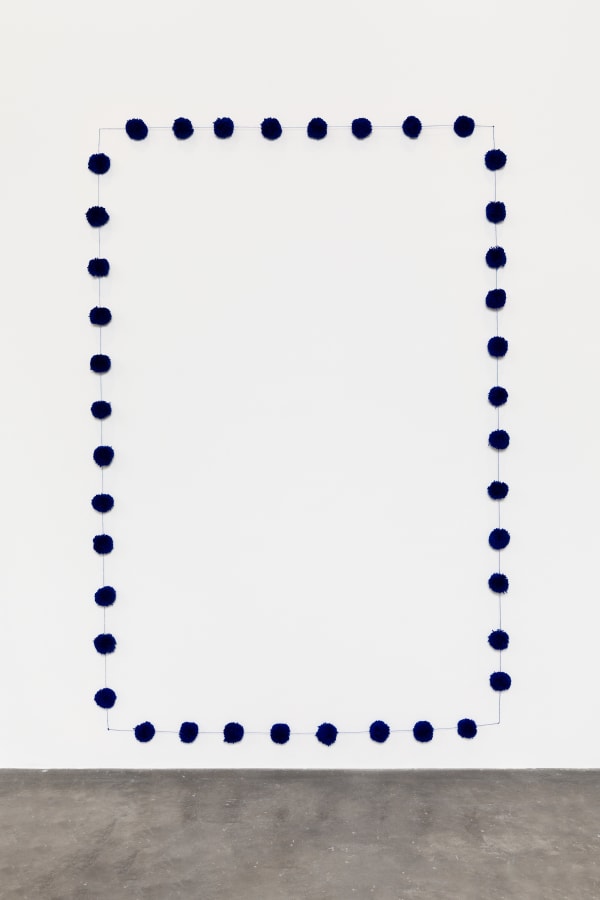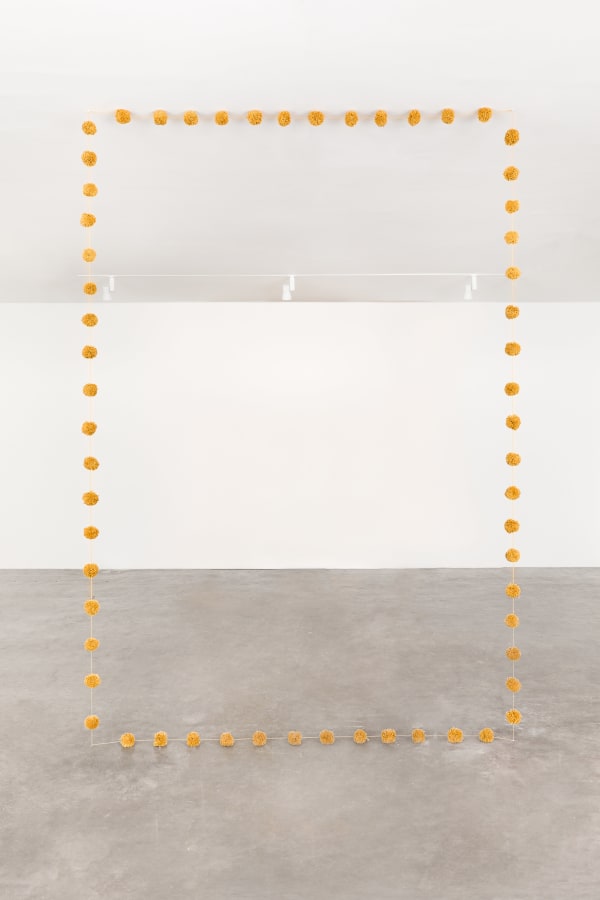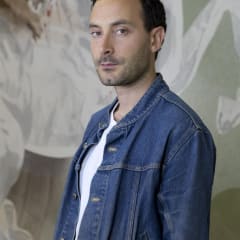Manikin Matthew Lutz-Kinoy
For Jogue a boneca para cima, which roughly translates to Puppet up, the artist took inspiration from Francisco Goya’s painting The Straw Manikin (1791-92), in which several young women playfully toss a doll in the air. Appropriate for this exhibition opening in São Paulo in February, this scene evokes carnivalesque performances involving masks, effigies, and gigantic puppets. Lutz-Kinoy retains the creepy uncanny undercurrents of Goya’s painting. His working process makes it possible to reproduce and recombine past figures in complex spatial compositions and visual disorientation. To this end, he employs a process traditionally used in set design for theater backdrops: he layers paper or plastic sheeting, draws over the surfaces, then cuts out the forms and sprays them with a gardening water compressor filled with diluted acrylic paint. In Jogue a boneca para cima, for example, this technique allowed the artist to abstract Goya’s figures, transforming them into ghost-like shadows floating in an ungrounded space.
Goya’s doll reappears on its way down in Lutz-Kinoy’s painting A queda da Marionete (The Fall of the Marionette). In this work, stenciled silhouettes of the manikin imply how systems of power impose stereotypes on society, forcing everything to conform to a particular template. The painting includes also several bird silhouettes, their patterning produced by using the same stencil. These profiled images refer to the rufous-bellied thrush, the Brazilian national bird. The repetition of these similar forms echoes the refrain of the well-known patriotic Brazilian poem Exile Song (1843), which repeatedly boasts: “My land has palm trees/Where the thrush sings”. While the work emphasizes territorial boundaries, it also suggests an opening to an outside. The flatness of the painted birds which seem to hover on the surface of the canvas resembles the decals placed on windows to prevent birds from hitting the glass. They thus exist in a liminal state between an inside and a world beyond, opening to lines of flight. Indeed, the layering technique creates ambiguous spatial effects. It’s not clear whether these are multiple figures or a single bird and manikin seen simultaneously in various states of transition. Furthermore, the point of view is from both above and below at the same time.
Certainly, various iterations of borders appear throughout the show. Take for example the pompom works which could function as empty frames, trim, or a portal on the fringes of another realm. Similarly, the boiserie panel paintings of hollyhock hung between the manikin works serve as ornamental dividers and hint at the marginal role attributed to decoration. Perhaps in the most literal reference to frontiers, two “camouflage” paintings loosely trace the contours of a geographic body, the Amazon River and its tributaries. These works allude to typical media views of landscapes taken from planes. Aerial photography is often considered a privileged perspective and has been closely linked to techniques of control used by the state and the military. The title Our skies have more stars, Our valleys have more flowers, another line from Exile Song, highlights the nationalistic viewpoint that often goes hand in hand with the demarcation and ownership of land. Of course, camouflage usually offers a means of blending into a landscape and concealing one’s identity, but these compositions do not fit the pattern of the established order. Lutz-Kinoy originally wanted to call this painting Gays in the Military for its “flamboyant” army fatigue motif. Even more so, River reveals a homo-erotic vision of a strapping nude male taken from a drawing by Paul Cadmus, an artist known for his controversial depictions of the Navy. The image vibrates with color and sensations, and plays between negative and positive space. These abstractions express intensities that - unlike extensive qualities - cannot fully be divided, measured, owned, or enclosed. Calling to mind Hélio Oiticica’s supra-sensory environments, they surpass the bounds of rational perception. In this way, they do not merely map an existing place but rather envision an alternative fictional space.
The show as a whole achieves cohesiveness through patterning as well as through the repetition of forms and mirroring. For example, birds resurface in a painting based on François Boucher’s Toilette of Venus (1751), a whimsical portrait of Madame de Pompadour as a goddess immersed in extravagance - doves, putti, and pearls. But in Lutz-Kinoy’s work entitled Birds’ First Trappings, the central character has vanished. Since the stenciling technique allows for the omission of layers, the artist decided to erase Madame de Pompadour and her luxurious accessories, leaving only the two doves as they fly through an indiscernible no man’s land. This work finds its counterpart in Enfants rois, a painting of the same size that similarly features two main subjects in an indeterminate moment of suspense. The painting reimagines Paul Delaroche’s Children of Edward (1830), a speculation on what might have occurred in the "Princes in the Tower" mystery when two princes locked away in the Tower of London disappeared in the late 1400s. Lutz-Kinoy’s painting presents the two ethereal young brothers huddled together in fear as they await their unknown fate.
Two other paintings share the same scale and mirror each other from across the gallery room. City Orchid depicts a lone abstract flower recalling the orchids given to concierges of apartment buildings in São Paulo and Rio de Janeiro. Oftentimes, when the orchids lose their flowers, the concierges bind them to trees in the city where they must adapt to urban gardening techniques and blossom anew. These tied up rejected orchids reflect the prisoner in Mad fury where the latticework of the jail cell resembles a gardening trellis. This imagery comes from another Goya work, the lithograph Lunatic Behind Bars (1828). In a nod to Nabokov’s story, Lutz-Kinoy’s painting again emphasizes limits - in this case, those of madness. In fact, like Goya’s lunatic, most of the recurring imagery in this show - birds, camouflage, orchids, prisoners, and manikins - relate to being trapped in some way. However, by mining history to resurrect these figures, the artist unties their strings from any fixed narrative, allowing them to speak for and amongst themselves.
—Zoe Stillpass














